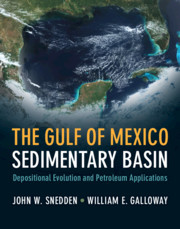Book contents
- The Gulf of Mexico Sedimentary Basin
- The Gulf of Mexico Sedimentary Basin
- Copyright page
- Dedication
- Contents
- Preface
- Abbreviations
- Part I Introduction
- Part II Mesozoic Depositional Evolution
- Part III Cenozoic Depositional Evolution
- Chapter 5 Cenozoic Depositional History 1
- Chapter 6 Cenozoic Depositional History 2
- Chapter 7 Cenozoic Depositional History 3
- Chapter 8 Cenozoic Depositional Synthesis and Emerging Hydrocarbon Plays
- Part IV Petroleum Habitat
- Glossary
- References
- Index
Chapter 7 - Cenozoic Depositional History 3
Neogene Tectono-climatic Phase
from Part III - Cenozoic Depositional Evolution
Published online by Cambridge University Press: 13 September 2019
- The Gulf of Mexico Sedimentary Basin
- The Gulf of Mexico Sedimentary Basin
- Copyright page
- Dedication
- Contents
- Preface
- Abbreviations
- Part I Introduction
- Part II Mesozoic Depositional Evolution
- Part III Cenozoic Depositional Evolution
- Chapter 5 Cenozoic Depositional History 1
- Chapter 6 Cenozoic Depositional History 2
- Chapter 7 Cenozoic Depositional History 3
- Chapter 8 Cenozoic Depositional Synthesis and Emerging Hydrocarbon Plays
- Part IV Petroleum Habitat
- Glossary
- References
- Index
Summary
The Middle Miocene marked the emergence of the Appalachian uplands as a significant sediment source to the Gulf of Mexico. As a result, the Tennessee River joined the Mississippi in creating the dominant fluvial/deltaic depocenter. At the same time, supply from western interior uplands decreased. Two Miocene deposodes and multiple eustatically modulated high-frequency Pliocene—Pleistocene deposodes are recorded in northern Gulf stratigraphy. The continental slope wedge prograded onto the shallow Sigsbee salt, initiating canopy deformation and rapid basinward canopy advance. Salt-encased minibasins created rugose slope topography with multiple, efficient sediment traps. Nonetheless, large volumes of sediment bypassed the continental slope and constructed a series of large, long-lived abyssal plain fans. A narrow coastal plain and shelf prograded along the western Gulf margin. Extensional growth faulting was compensated basinward by compressional faulting and folding above Paleogene detachments. In the Sureste, the river-fed, prograding continental margin and ongoing basement deformation mobilized salt of the Campeche Salt Basin.
Keywords
- Type
- Chapter
- Information
- The Gulf of Mexico Sedimentary BasinDepositional Evolution and Petroleum Applications, pp. 211 - 230Publisher: Cambridge University PressPrint publication year: 2019

